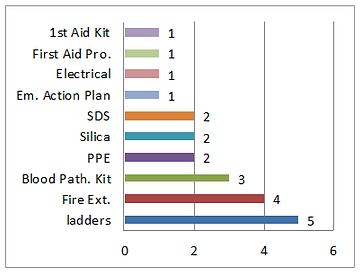It’s 2019!
Hope Everyone Had a Happy and Safe Holiday Season
Culbertson would like to extend its’ appreciation to all of you for a job well done in 2018 and thanks for your continued involvement in our safety program.
As 2019 gets started, lets all do our part to make this an Accident/Incident Free Year.
The chart above shows the top ten citations found by SEE, Inc. for 2018.
As you can see there are several categories that we need to focus on.
- Ladders —Always inspect a ladder before use. If there is any problems with it, immediately tag it out of use and find a properly functioning ladder. Use the correct ladder for the job. There are many types of ladders to work in different situations. Check weight ratings to ensure you do not overload the ladder during use. Always secure the ladder. Make sure the ladder is stable on the ground before climbing up. Tie off the ladder to the structure you are next to. Have someone hold the ladder to secure it.
- Fire Extinguishers—must be inspected every 30 days and serviced or replaced every 12 months with the dates noted on the inspection tag/document. Empty/discharged fire extinguishers must be removed from site immediately and replaced
- Bloodborne Pathogens Kit— OSHA’s Blood borne Pathogen Standard, 29 CFR Part 1910.1030, sets forth requirements to protect workers from occupational exposure to blood borne pathogens. The standard covers all employees, who could be reasonably anticipated as the result of performing their job duties, to face contact with blood and other potentially infectious materials.
All-Day Safety
All employees must keep safety on their minds all day. It’s not something you think about just now and then. Always follow these safe work practices:
- Wear approved safety footwear suitable for your trade.
- Wear clothing suitable for weather and your work.
- Never wear torn or loose clothing.
- Use gloves and other suitable skin protection when handling rough materials, chemicals, and hot or cold objects.
- If safety equipment is provided for your protection, use it.
- Locate gas, power, and water sources before starting excavation.
- Flammable liquid should be used in small amounts and in an approved metal safe can.
- Do not refuel a hot or running engine.
- Clean up spills before starting engines.
- Keep safe access to work areas.
- Place excavation spoil away from the trench edge to avoid load strain on walls.
- Do not allow vehicles too close to the ditch’s edge.
- Bend knees and back nearly straight when lifting. Leg muscles, not your back, should do the work.
- Get help with heavy loads.
- Intoxicants and non-prescribed drugs are not permitted on any job site.
- Work with care and good judgment at all times to avoid accidents.
Proper Clothing
What do you normally wear each day on the job site? Is it safe for the type of construction work you’re doing all day? Has your employer issued you personal protective equipment? You should consider the following factors to determine if your clothing is safe: Always wear your hard hat on the job site.






